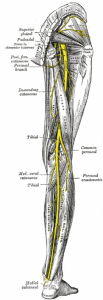
Sciatica is a term used to describe nerve pain in the leg that is caused by irritation and/or compression of the sciatic nerve. Sciatica originates in the lower back, radiates deep into the buttock, and travels down the leg.
A common mistake is referring to any low back pain or radicular leg pain as sciatica.
Rather sciatica is a clinical diagnosis based on the presence of radiating pain in one leg, with or without the associated neurological deficits of paraesthesia and muscle weakness, which are the direct result of sciatic nerve or sciatic nerve root pathology.
Sciatica pain often is worsened with flexion of the lumbar spine, twisting, bending, or coughing.
The Sciatic Nerve
The sciatic nerves branches from your lower back through your hips and buttocks and down each leg. More specifically is starts in the lower spine: a combination of 5 nerve roots that exit from inside the lower lumbar and upper sacral spine—L4, L5, S1, S2, and S3—forms the sciatic nerve.
Where your sciatic nerve starts in your lower back is only about 1 centimetre wide. As the nerve extends down your legs, it widens slightly. At its thickest point, your sciatic nerve is about 2 centimetres in diameter.
As we know, it’s the longest nerve in the body, distally it branches medially to the Tibial Nerve and laterally to the Common Peroneal Nerve.
The Sciatic Nerve pathway
In the pelvis, the sciatic nerve and a few other surrounding nerves and blood vessels exit through an opening called the greater sciatic foramen (sciatic notch).
This opening is located deep in the buttock, just below the piriformis muscle, and descends between the greater trochanter of the Femur and the ischial tuberosity.
It then courses down and runs below and along the side of the gluteus maximus muscle.
The nerve descends by crossing behind a combination of muscles located deep in the hip joint, namely Obturator Internus, the Gemelli Muscles and Quadratus Femoris.
At the lower edge of the gluteus maximus muscle of the buttock, the nerve reaches the back portion of the upper thigh, where it lies on the posterior surface of Adductor Magnus.
Nerves branch off to the hamstring muscles. The nerve is crossed by the long head of Biceps Femoris.
The nerve ends at the upper aspect of the popliteal fossa where it branches to distal nerves.
Treatment
In most cases of sciatica, conservative treatment is favoured. The evidence does not show that one treatment is superior to the other
How Exercise Can Help

The basic aim is to improve ROM, to reduce tension on the sciatic nerve wherever its being impinged and to reverse and retrain maladaptive movement patterns.
In about 90% of cases sciatica is caused by a herniated disc with nerve root compression. In such cases, improving length around the hips won’t be sufficient in managing and reversing the sciatic pain, understanding that the muscles are tight in consequence of the disc herniation, and to be more targeted, you need to take a more functional approach in treatment.
Tight muscles are usually weak muscles, compensating for lack of strength by tightening up and guarding the area. Therefore, to lengthen and strengthen and improve movements patterns in the approach I take when prescribing exercise for those with sciatica.
Physical activity increases incidence in those with prior sciatic symptoms and decreased in those with no prior symptoms.
To ensure your safety, always consult with your health professionals before commencing exercise treatment. This is where an exercise physiologist is very beneficial, as they can design an individualised exercise prescription targeted at your specific movement patterns to ensure you get the most effective and efficient prescription.




